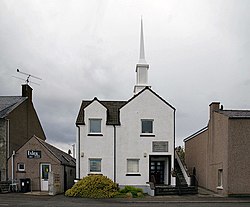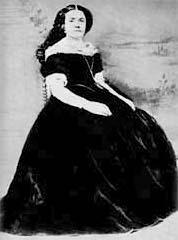The Church of Jesus Christ of Latter-day Saints in Scotland
 From Wikipedia - Reading time: 15 min
From Wikipedia - Reading time: 15 min
The Church of Jesus Christ of Latter-day Saints in Scotland | |
|---|---|
 A meetinghouse for the Branch in Stornoway, Outer Hebrides | |
| Area | Europe North |
| Stakes | 5[1] |
| Wards | 24 |
| Branches | 11 |
| Total Congregations[2] | 35 |
| Missions | 1 |
| FamilySearch Centers | 19[3] |
| Religion in Scotland |
|---|
 |
|
|
The Church of Jesus Christ of Latter-day Saints in Scotland is the Scottish branch of the Church of Jesus Christ of Latter-day Saints (LDS Church).
History
[edit]First Missionaries in Scotland
[edit]Wright and Mulliner
[edit]Two native Scots, Alexander Wright and Samuel Mulliner, became the first missionaries to Scotland after they were converted whilst living in Ontario, Canada, arriving 20 December 1839.[4] The elders began teaching the gospel to their own families, so they traveled to Edinburgh to visit Elder Mulliner's parents. After which Wright traveled to Marnoch in Banffshire to share the gospel with his family despite suffering from smallpox.[5] The two elders reunited and began preaching systematically in Glasgow.[5] On 14 January 1840 Mulliner baptised the first converts in Scotland, Alexander Hay and his wife Jessie, in the River Clyde at Bishopton near Paisley.[4] Mulliner and Wright reunited and on 2 February 1840 baptised two young men from Leith.[6]
Orson Pratt's missionary efforts
[edit]
Orson Pratt arrived in Scotland on 8 May 1840 to supervise the missionaries. At the time of Pratt's arrival, there were 80 Latter-day Saints in the area,[4] thanks to the missionary efforts of Wright and Mulliner so Pratt was able to organise the first branch of the church in Scotland at Paisley.[7][8] Pratt earnestly prayed for 200 converts at Arthur's Seat, a hill in Holyrood Park, Edinburgh.[9][10] Pratt called two more missionaries to the area: Hiram Clark and Reuben Hedlock. They worked alongside Wright in Paisley, while Pratt and Mulliner began proselyting in Edinburgh. Mulliner would return to the United States in 1840.[5]
Pratt and Mulliner preached in every night in the streets of the city, and were able to baptise 23 new converts by the end of the summer on 1840. Pratt was unsatisfied with their success in the area and decided to try a new approach: writing.[5] While in Edinburgh, Pratt wrote and published the pamphlet An Interesting Account of Several Remarkable Visions. It included the first published account of Joseph Smith's first vision, and with the scriptures, became a standard Church publication in Scotland.[11] Pratt distributed this pamphlet for 10 months until he returned home in March 1841, leaving the mission under George D. Watt. Pratt would later return to Scotland throughout this life to visit the saints there. Wright remained in Scotland until 1842. Due to the efforts of these early missionaries, there were 70 branches by 1848,[5] and by 1853 the church had grown to over 3,000 members.[4]
Church decline in the late 19th century
[edit]Early church members were usually workers in lowland industrial areas who turned to religion out of a "reflex of despair." Despite attempts at Gaelic language preaching by William McKay in 1847, and even the printing of a Gaelic language pamphlet "Do Luchdsiridh Rioghachd Dhe" (Seekers after the Kingdom of God) in 1850, few Highlanders joined the church.[12]
With an increase in church membership, there were four conferences held in Scotland in Glasgow, Kilmarnock, Edinburgh, and Dundee between 1855 and 1859. This church growth did not go unnoticed. Some of the church members in the mid-19th century were persecuted. Violent acts occurred in Kirkpatrick when members were stoned, and also in Busby where mobs gathered. In 1850 Scots law "prohibited the disruption of religious assemblies" to avoid violence in Edinburgh.[13]

Despite these strong early beginnings, the church would face a decline in membership after the 1850s due to a number of factors. The church had encouraged members to join with the Saints in the United States and emigrate to Utah. In the 1850s, 1,800 church members emigrated to the U.S. and approximately 1,600 members emigrated during the next decade. Missionaries during this time period also reported that fewer people were interested in learning about the church and there was a "spirit of indifference," perhaps attributed to the reformations and revitalisation of the Church of Scotland. Large groups of church members were also excommunicated for violations of church standards. Scotland was also in a depression during this time which could have contributed to church decline, along with other potential factors. Mormonism was effectively stagnant until the 1960s when new social and economic conditions were established in the country.[13]
In March 1862 the Apostle Amasa Mason Lyman gave a speech in Dundee which, when 5 years later Brigham Young and other Mormon leaders saw a copy of it, would lead to him being stripped of his apostleship.[14]
A well-organised 'anti-Mormon' campaign was mounted by various ministers and Latter-day Saints who had turned from the church. They lectured and published pamphlets accusing the missionary programme of being a disguise for Americans to enslave British girls as polygamous wives.[15] Missionaries were sometimes attacked. Opponents of the LDS Church demanded that Home Secretary Winston Churchill and the Home Office persuade Parliament to expel Latter-day Saint missionaries and refuse entry to more. Churchill opposed exaggerated claims and collected favorable police reports from key cities. When the 'Mormon question' came up in Parliament again, Churchill said that although he had not completed his investigation, he had found nothing against the LDS Church members.[16]
When the First World War began in 1914, all American LDS Church missionaries in Scotland, as throughout the United Kingdom, were evacuated back to the USA.[9] The Lloyd George ministry banned the church's missionaries from reentering Britain in 1918 after the war, despite mission president George Albert Smith's protest that they had peacefully worked in Britain for more than 80 years. Missionaries would not return in significant numbers until mid-1920, after United States Senators Reed Smoot and William H. King caused the American State Department to intervene.[17][18] The movie Trapped by the Mormons, inspired by Winifred Graham's book of the same title, led to widespread anti-Mormon rhetoric throughout the British Isles.[18] The ban on LDS missionaries was in part because of fears of the prewar anti-Mormon violence resuming, but except for one 1922 attack during a church service in Edinburgh where a crowd of 100 students tarred and feathered two elderly missionaries and a church member,[19] incidents were minor. Although Graham and other anti-Mormons continued to denounce the church, the government told them that there was no evidence that missionaries were acting in a way to justify deportation.[17]
After the outbreak of the Second World War all the church's American missionaries were again evacuated. This was completed by early 1940 when Hugh B. Brown, then serving as president of the British Mission, returned to the USA. In his place a local Latter-day Saint, Andre K. Anastasiou, was appointed. Brown returned to the UK on 29 March 1944 and again began serving as the mission president. American missionaries would begin to return in 1946.[20]
1950s to present
[edit]Beginning in the 1950s emigration to the United States began to be discouraged and local congregations began to proliferate. The members in Scotland were in the British Mission until it was split in 1960; they then became part of the North British Mission. The following year the Scottish-Irish Mission was formed, which was later divided. The first stake was formed in Glasgow in 1962, and 13 years later the second stake was established in Dundee.[4] The Scottish mission has since been merged back in with the Irish one.
Today, church members in Scotland participate in all church auxiliary programs including seminary and institute, and many of the young LDS men and women serve missions for the church.[4]
Stakes and Congregations
[edit]As of June 2024[update], the following Stakes and Congregations were located in Scotland:[21]
Aberdeen Scotland Stake
- Aberdeen Ward
- Bridge of Don Ward
- Buchan Ward
- Elgin Branch
- Invergordon Branch
- Inverness Ward
- Kirkwall Branch
- Lerwick Branch
- Stornoway Branch
- Thurso Branch
Dundee Scotland Stake
- Dundee 2nd Ward
- Dundee Bingham Ward
- Dunfermline Ward
- Kirkcaldy Ward
- Montrose Ward
- Perth Branch

Edinburgh Scotland Stake
- Alloa Ward
- Dalkeith Ward
- Dumfries Ward
- Edinburgh Ward
- Falkirk Branch
- Galashiels Branch
- Livingston Ward
Glasgow Scotland Stake
- Airdrie Ward
- Dumbarton Ward
- East Kilbride Ward
- Glasgow Ward
- Motherwell Ward
Paisley Scotland Stake
- Ayr Ward
- Greenock Branch
- Irvine Ward
- Kilmarnock Ward
- Paisley Ward
- Pollok Ward
- Stranraer Branch
Missions
[edit]There is currently a single mission serving Scotland, which is shared with Ireland:
- Scotland/Ireland Mission
Temples
[edit]There are currently no LDS temples in Scotland. The Preston England Temple in Lancashire has served Scotland since 1998. At the April 2024 General Conference, it was announced that a temple will be constructed in Edinburgh.
|
edit | ||
| Location: Announced: |
Edinburgh, Scotland 7 April 2024 by Russell M. Nelson[22][23] | ||
Notable Scottish Latter-day Saints
[edit]

- Brian Adam — first Latter-day Saint member of the Scottish Parliament, and later became a government minister
- David S. Baxter, First Quorum of the Seventy, born in Scotland, moved to England as a child.
- Eilley Bowers, born in Scotland, emigrated to the United States after becoming a Latter-Day Saint. She was, in her time, one of the richest women in the United States though she died penniless.
- Johnny Cunningham, folk musician in Silly Wizard, brother of Phil (left the church)
- Phil Cunningham, accordionist and folk musician. (left the church)
- Stephen Kerr, Scottish Conservative MP and MSP
- John Lyon, poet and writer of the American frontier.
- Stanley Robertson, master storyteller, ballad singer and author of several books of Lowland Traveller tales.[24]
- Robert Sands (conductor), born in Ireland, but converted while living in Scotland.
- Jane McKechnie Walton, born in Scotland, emigrated to the United States as a young child after her family converted.
See also
[edit]References
[edit]- ^ Classic Maps, The Church of Jesus Christ of Latter-day Saints, retrieved 27 April 2021
- ^ Excludes groups meeting separate from wards and branches
- ^ Scotland Family History Centers, familysearch.org, retrieved 18 August 2022
- ^ a b c d e f Cuthbert, Muriel (October 1978). "The Saints around the World: Strong Saints in Scotland". Ensign.
- ^ a b c d e England, Breck (February 1987). "Gospel Seeds in Scottish Soil". Ensign.
- ^ Mulliner, Samuel. "Samuel Mulliner History".
- ^ Mays, Kenneth (12 December 2012). "Picturing history: Paisley, Scotland". Deseret News. Archived from the original on 29 June 2013. Retrieved 5 January 2014.
- ^ Buchanan, Frederick S. (1 April 1987). "The Ebb and Flow of Mormonism in Scotland, 1840-1900". BYU Studies. 27 (2): 27. Retrieved 4 December 2020.
- ^ a b Evans, Richard L. (1984) [1937]. A Century of "Mormonism" in Great Britain. Salt Lake City: Publishers Press. ISBN 091609507X. OCLC 866138200.
- ^ Whittaker, David J.; Esplin, Ronald K.; Allen, James B., eds. (1992), "Orson Pratt in Scotland", Men with a mission, 1837-1841: the Quorum of the Twelve Apostles in the British Isles, Salt Lake City, Utah: Deseret Book, ISBN 978-0-87579-546-1, OCLC 24375869
- ^ Whittaker, David J. (Fall 2004). "Mormon Historic Studies" (PDF). Mormon Historic Studies: 79–100.
- ^ Buchanan, Frederick S. (1 April 1987). "The Ebb and Flow of Mormonism in Scotland, 1840-1900". BYU Studies. 27 (2): 30–31. Retrieved 4 December 2020.; This is written as "Do Suchdsiridh Kioghachd Dhe" (sic) in the source, which is a mistranscription of the Gaelic spelling. "K" is not used in Gaelic.
- ^ a b Buchanan, Frederick S. "The ebb and Flow of Mormonism in Scotland, 1840-1900": 27–52.
{{cite journal}}: Cite journal requires|journal=(help) - ^ Hefner, Loretta L. (1992), "From Apostle to Apostate: The Personal Struggle of Amasa Mason Lyman" (PDF), Dialogue: A Journal of Mormon Thought, 16 (1), Dialogue Foundation: 99–101, retrieved 29 April 2015
- ^ Perkins, Jerome M. (2007). "The Story of the British Saints in Their Own Words, 1900–50". In Doxey, Cynthia; Freeman, Robert C.; Holzapfel, Richard Neitzel; Wright, Dennis A. (eds.). Regional Studies in Latter-day Saint Church History: The British Isles. Provo, Utah: Religious Studies Center, Brigham Young University. pp. 149–69. ISBN 978-0-8425-2672-2. LCCN 2008298997. OCLC 181088736. Archived from the original on 7 November 2011.
- ^ Hoopes, David S.; Hoopes, Roy (1990). The Making of a Mormon Apostle: The Story of Rudger Clawson. Landham, MD: Madison Books. p. 263. ISBN 978-0819172983. LCCN 89031917. OCLC 19514770.
- ^ a b Thorp, Malcolm R. (1979). "The British Government and the Mormon Question, 1910-1922". Journal of Church and State. 21 (2): 305–323. doi:10.1093/jcs/21.2.305. ISSN 0021-969X. JSTOR 23915804.
- ^ a b Parrish, Alan K. (2007). "Turning the Media Image of the Church in Great Britain, 1922–33". In Doxey, Cynthia; Freeman, Robert C.; Holzapfel, Richard Neitzel; Wright, Dennis A. (eds.). Regional Studies in Latter-day Saint Church History: The British Isles. Provo, Utah: Religious Studies Center, Brigham Young University. pp. 171–92. ISBN 978-0-8425-2672-2. LCCN 2008298997. OCLC 181088736. Archived from the original on 7 November 2011.
- ^ Bergera, Gary James (2009). "Benson's 1921-1923 Mission". Journal of Mormon History. 35 (4): 103. Retrieved 5 December 2020.
- ^ Boone, David F. ""The King of Kings Needs a Few Men": British Saints during World War II". Brigham Young University. Retrieved 4 September 2014.
- ^ "Classic Maps", churchofjesuschrist.org, retrieved 5 June 2021
- ^ Full summary of Sunday’s LDS General Conference: Nelson names temples; Oaks reaffirms wearing of garments; Kearon points to a welcoming God, Salt Lake Tribune, 7 April 2024
- ^ "President Russell M. Nelson Announces 15 Temples", Newsroom, LDS Church, 7 April 2024
- ^ Schofield, Derek (7 October 2009). "Stanley Robertson obituary". The Guardian. Retrieved 7 May 2018.
External links
[edit]- Newsroom (United Kingdom & Ireland)
- The Church of Jesus Christ of Latter-day Saints (UK and Ireland) – Official Site
- Joseph Smith Papers "An Interesting Account of Several Remarkable Visions, 1840"
 KSF
KSF